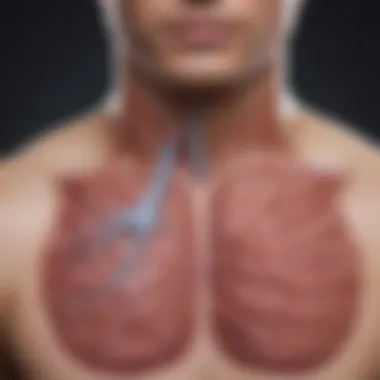Exploring Nitric Oxide in Mechanical Ventilation


Intro
Nitric oxide plays a significant role in mechanical ventilation, particularly in enhancing respiratory function. This article explores its physiological effects and how it may benefit patients suffering from acute respiratory distress syndrome (ARDS) and other pulmonary complications. By examining current research and clinical practices, we aim to present a comprehensive overview of nitric oxide's critical contributions to ventilation.
Recent studies indicate that the introduction of nitric oxide into ventilatory strategies can improve gas exchange and promote pulmonary vasodilation. The growing body of evidence supports its use not only in ARDS but also in broader contexts, shedding light on the importance of this molecule in respiratory care.
Emerging technologies around nitric oxide ventilation devices are notable, too. Understanding the mechanisms by which nitric oxide operates can lead to safer and more effective treatment options for patients in distress. As we proceed, we will highlight key findings, explore implications, and evaluate current methodologies in the context of nitric oxide use in mechanical ventilation.
Research Highlights
Key Findings
- Nitric oxide significantly enhances gas exchange by improving ventilation-perfusion matching.
- Its vasodilatory effects help reduce pulmonary hypertension, making it vital for ARDS management.
- Research supports the use of nitric oxide in various clinical settings, including post-operative recovery and during severe respiratory infections.
Implications and Applications
The findings have profound implications for clinical practice. Nitric oxide has emerged as a potential therapy in improving outcomes for patients with respiratory distress. Potential applications include:
- Integration into ventilatory support systems.
- Use in emergency medicine for quickly stabilizing patients.
- Adapting protocols for chronic respiratory conditions.
Furthermore, the development of nitric oxide ventilators is a promising avenue for technological advancement in respiratory care. By understanding how nitric oxide operates, clinicians can effectively tailor treatment to optimize patient outcomes.
Methodology Overview
Research Design
This exploration compiles data from various studies focused on nitric oxide therapy. Systematic reviews and meta-analyses contribute to a clearer understanding of its efficacy and safety.
Experimental Procedures
The research methodology involved:
- Literature Review: A comprehensive review of the existing literature surrounding nitric oxide and its applications in mechanical ventilation.
- Clinical Trials: Evaluation of clinical trials examining the outcomes of nitric oxide in patients with ARDS.
- Data Analysis: Statistical analysis to determine the significance of observed effects and outcomes.
Prelude to Nitric Oxide
Nitric oxide (NO) is a simple molecule but packed with significance, especially in the field of medicine. Understanding nitric oxide is critical for comprehending its applications in mechanical ventilation and respiratory therapy. This section delves into its chemical properties and physiological roles. It highlights how NO functions as a crucial signaling molecule in various biological processes, thus setting the stage for its therapeutic uses.
Chemical Properties
Nitric oxide is a colorless gas under standard conditions, with a very short half-life due to rapid reaction with oxygen to form nitrogen dioxide. Its molecular formula is NO, and it has an unpaired electron, making it a free radical. This characteristic enables nitric oxide to easily diffuse across cell membranes, allowing it to act quickly within the body.
Some important properties of nitric oxide include:
- Gas Phase: As a gas at room temperature, nitric oxide is easily inhaled and distributed within tissues.
- Reactivity: It reacts with various biomolecules, including thiols and superoxide radicals. This reactivity is key to its function in the body.
- Solubility: Nitric oxide is soluble in water, which enhances its bioavailability in vascular systems.
These chemical properties underline nitric oxide's potential for therapeutic use in ventilation strategies and respiratory therapies.
Physiological Role
Nitric oxide plays numerous roles in human physiology, particularly in the cardiovascular and pulmonary systems. It serves as a vasodilator, meaning it helps in relaxing and widening blood vessels. This function is significant for enhancing blood flow and delivering oxygen to tissues.
Key physiological roles of nitric oxide include:
- Vasodilation: NO signals smooth muscle to relax, which can lower blood pressure and improve circulation.
- Neurotransmission: It is involved in signaling pathways in the nervous system, helping in processes such as memory formation and pain sensation.
- Immune Response: Nitric oxide has antimicrobial properties, assisting the immune system in fighting off pathogens.
Overall, the importance of nitric oxide in physiological processes can not be overstated. Its roles in vasodilation and communication within the body form a foundation for its application in treating various conditions, particularly in respiratory therapies. This sets a critical context as we explore nitric oxide's integration with mechanical ventilation and its benefits in critical care.
Understanding Mechanical Ventilation


Mechanical ventilation is a cornerstone of modern critical care. It provides support to patients whose respiratory systems cannot function adequately on their own. Understanding this concept is crucial as it lays the groundwork for discussing how nitric oxide can enhance therapeutic outcomes in various clinical scenarios.
Mechanical ventilation helps maintain adequate gas exchange and can prevent respiratory failure. Patients with conditions such as acute respiratory distress syndrome (ARDS) or chronic obstructive pulmonary disease (COPD) often require mechanical support. A clear comprehension of mechanical ventilation is vital for healthcare providers to make informed decisions and optimize patient care.
Basics of Mechanical Ventilation
Mechanical ventilation is the practice of using devices to assist or replace spontaneous breathing. It can be divided into two main types: invasive and non-invasive.
- Invasive ventilation involves the insertion of a tube into the airway, typically through the mouth or nose. This method allows for precise control of ventilation parameters.
- Non-invasive ventilation uses a mask to deliver air to the patient without the need for intubation. It is often employed in less severe cases, where the integrity of the airway is maintained.
Both methods have specific indications, benefits, and considerations. For instance, invasive ventilation can be necessary for patients unable to protect their airways. However, it also carries risks, such as infection or injury to the trachea.
Indications for Mechanical Support
The indications for mechanical ventilation can broadly apply to various clinical conditions. Some common reasons include:
- Acute Respiratory Failure: Conditions causing sudden breathing difficulties, such as pneumonia or pulmonary embolism.
- Neuromuscular Disorders: Diseases like amyotrophic lateral sclerosis (ALS) may weaken respiratory muscles, necessitating ventilatory support.
- Severe Asthma Exacerbations: In cases where traditional therapies fail to improve breathing.
- Postoperative Respiration: Patients recovering from surgery may need temporary ventilation, especially after thoracic procedures.
Mechanical ventilation is indispensable in safeguarding patients during critical episodes, and understanding its applications is essential for its effective utilization in conjunction with therapies like nitric oxide. By integrating knowledge of mechanical ventilation with the potential benefits of nitric oxide therapy, practitioners can better address the needs of their patients.
The Role of Nitric Oxide in Respiratory Therapy
Nitric oxide holds significant relevance in the realm of respiratory therapy. Its unique properties make it especially effective in managing various pulmonary conditions. As a molecule that helps facilitate vasodilation, nitric oxide can improve blood flow and oxygen delivery in the lungs. This is crucial in settings such as acute respiratory distress syndrome (ARDS), where oxygen circulation is often impaired. Furthermore, it serves as a pulmonary vasodilator, which is vital for patients with pulmonary hypertension. Understanding the implications of nitric oxide therapy not only aids in clinical practice but also guides future research and technology development in this area.
Mechanism of Action
The mechanism of action for nitric oxide in respiratory therapy is fundamentally linked to its role as a signaling molecule. When inhaled, nitric oxide diffuses across cell membranes and stimulates the guanylate cyclase enzyme. This leads to increased concentrations of cyclic guanosine monophosphate (cGMP) in smooth muscle cells. The elevation of cGMP results in relaxation of the vascular smooth muscles, causing dilation of the pulmonary and systemic blood vessels. This process enables improved blood flow throughout the lungs. The precise control of nitric oxide levels is vital. Higher concentrations can increase pulmonary blood flow, while excessively low levels may limit oxygenation.
Effects on Pulmonary Vasodilation
The effects of nitric oxide on pulmonary vasodilation are profound and have substantial clinical importance. By promoting vascular relaxation, nitric oxide enhances perfusion in regions of the lungs that are receiving adequate ventilation. This selective improvement in blood flow can lead to more efficient gas exchange processes. Clinically, this has numerous implications for patients suffering from conditions such as ARDS and pulmonary hypertension.
Research shows that when nitric oxide is administered to patients with these conditions, there is often a noticeable improvement in oxygenation. This is reflected in reduced shunting of blood away from ventilated alveoli, which significantly improves oxygen delivery to the bloodstream.
According to studies, nitric oxide therapy can result in a 30-50% improvement in oxygenation index in patients with ARDS.
In summary, nitric oxide plays a crucial role in respiratory therapy through its mechanisms of action and effects on pulmonary vasodilation. Its applications hold tremendous potential in improving patient outcomes across various respiratory disorders.
Clinical Applications of Nitric Oxide Ventilation
The application of nitric oxide in mechanical ventilation represents a significant advancement in respiratory therapy. This section will discuss various clinical applications, outlining how nitric oxide contributes to improving patient outcomes and why it is essential in modern medical practice.
Treatment of ARDS
Acute respiratory distress syndrome (ARDS) is a critical condition characterized by widespread inflammation in the lungs. Nitric oxide has shown promise in the treatment of ARDS by promoting pulmonary vasodilation and enhancing oxygenation. The mechanism of action involves the relaxation of smooth muscle in the pulmonary vasculature, leading to improved blood flow and gas exchange. Clinical studies indicate that the use of inhaled nitric oxide can significantly reduce shunting of blood in the lungs, thus augmenting lung function. Its benefits are particularly notable in patients who do not respond adequately to conventional therapies.
- Key benefits of nitric oxide treatment for ARDS include:
- Reduction in pulmonary arterial pressure
- Enhanced blood oxygen levels
- Alleviation of hypoxia-related complications
This therapy is not without challenges. Potential side effects include the formation of nitrogen dioxide, which can be toxic at high concentrations. Therefore, careful monitoring and dose adjustment are essential during treatment.
Use in Preoperative Care
In preoperative settings, the administration of nitric oxide can be beneficial in managing patients with existing pulmonary conditions. It helps in optimizing oxygenation before surgical procedures, particularly those involving the lungs or the heart. Improved oxygenation leads to better outcomes in critical surgeries, reducing the risk of intraoperative complications.
- Considerations when using nitric oxide in preoperative care:
- Assessing lung function pre-surgery
- Monitoring patients’ responses to nitric oxide
- Establishing a protocol for safe administration


In addition, the use of nitric oxide can facilitate recovery by minimizing postoperative complications, such as atelectasis and pneumonia, as it aids in maintaining proper lung ventilation and perfusion.
Management of Pulmonary Hypertension
Pulmonary hypertension is another area where nitric oxide ventilation plays a crucial role. Inhaled nitric oxide is known to selectively dilate pulmonary blood vessels, relieving pressure in the pulmonary circulation. This action decreases the workload on the right ventricle and improves overall cardiac function.
The use of nitric oxide in treating pulmonary hypertension is well-documented. It is especially important for patients with various underlying conditions, such as chronic obstructive pulmonary disease (COPD) or left heart disease.
- Benefits of using nitric oxide in managing pulmonary hypertension:
- Improved exercise tolerance
- Better quality of life for patients
- Reduced hospitalizations due to exacerbations
However, ongoing assessment of patient response is vital. There can be complications if used long-term, including tolerance development, which may necessitate alternative therapies.
"Inhaled nitric oxide represents an important tool in optimizing respiratory management across various critical health conditions. Its targeted effects can dramatically influence patient outcomes in acute and chronic scenarios."
In summary, the clinical applications of nitric oxide ventilation span across critical areas in respiratory care. Its role in treating ARDS, enhancing preoperative safety, and managing pulmonary hypertension illustrates its value in modern medicine. Each application, while beneficial, necessitates a thorough understanding of the associated risks and careful clinical governance to maximize outcomes.
Emerging Technologies in Nitric Oxide Delivery
The exploration of emerging technologies in nitric oxide delivery is crucial for understanding how advancements can impact clinical practices. Nitric oxide has shown significant potential in enhancing respiratory therapy. Modern innovations aim to maximize its effectiveness while ensuring patient safety and comfort. These technologies focus on precision in delivery and integration into existing medical systems, a trend that reflects the evolving landscape of respiratory care.
Innovations in Delivery Systems
Innovative delivery systems for nitric oxide are being developed to address both dosage and effectiveness. These advancements focus on optimizing the delivery mechanism to ensure accurate dosing while minimizing waste. For instance, systems that utilize laser technology can enhance the targeting of nitric oxide to achieve better therapeutic outcomes.
Recent innovations include portable systems which enable at-home use, widening accessibility for chronic respiratory patients. These devices can monitor real-time data, such as pressure and flow, adjusting delivery accordingly. Additionally, microfluidic devices offer a promising avenue in delivering nitric oxide in controlled and steady amounts, a method critical for patients requiring continuous support.
Considerations must include usability, especially for non-medical personnel. Training and easy-to-follow interfaces will be essential. The development cycle of these innovations entails rigorous testing to confirm efficacy and safety across diverse patient populations.
"The precision in delivery is as important as the compound itself. Innovations in delivery systems can redefine patient outcomes and expand nitric oxide's potential use."
Integration with Ventilator Systems
The integration of nitric oxide delivery systems with traditional ventilators marks a significant advancement in respiratory therapy. This integration seeks to streamline processes during mechanical ventilation, increasing efficiency and patient outcomes. Ventilators now increasingly feature built-in nitric oxide delivery capabilities, allowing simultaneous oxygen delivery and nitric oxide administration.
This consolidation is beneficial because it reduces the need for separate systems, which can complicate patient management. Enhanced biofeedback mechanisms in ventilators can also facilitate the adjustment of nitric oxide levels based on patient response, ensuring optimal therapeutic dosing.
Moreover, integration helps in managing conditions like ARDS, where patients require complex interventions. Predictive analytics may also play a role. Data from ventilators could inform clinicians about the best times to administer nitric oxide, thus improving patient care protocols.
Overall, the shift to integrated systems illustrates a commitment to improving clinical outcomes while simplifying the complexities of mechanical ventilation. As technology evolves, so does the potential for better management of respiratory disorders.
Safety and Efficacy of Nitric Oxide Ventilators
The safety and efficacy of nitric oxide ventilators are critical elements to understand when considering their application in clinical settings. Nitric oxide itself is a potent vasodilator, which means it can enhance blood flow and improve conditions in patients facing respiratory challenges. However, its use must be accompanied by a careful assessment of potential risks and benefits to ensure that treatment does not introduce additional complications. This section investigates how these factors come into play and the relevance they hold for healthcare professionals.
Assessment of Risks
Assessing the risks associated with nitric oxide ventilation is paramount in ensuring patient safety. Potential adverse effects include the formation of methemoglobin, which can compromise the oxygen-carrying capacity of blood. Methemoglobinemia can occur when nitric oxide interacts with hemoglobin in a certain way. Therefore, monitoring hemoglobin levels during treatment is essential.
Other risks can involve respiratory irritation or the development of pulmonary toxicity from nitrogen dioxide, a byproduct when nitric oxide is mixed with oxygen. Although the concentrations in therapeutic use are typically low, an accurate measurement of exposure is necessary to mitigate any risks. The clinical team must also consider individual patient factors such as preexisting conditions, drug interactions, and overall health status.
Recent findings suggest that proper implementation and monitoring can greatly reduce the incidence of adverse effects. Training healthcare providers on the correct use and potential risks associated with nitric oxide can improve safety outcomes for patients.
Clinical Trials and Outcomes
Clinical trials play a vital role in evaluating the outcomes of nitric oxide ventilators. Numerous studies have focused on the safety and efficacy of nitric oxide therapy in various patient populations, especially those suffering from ARDS. Results show mixed outcomes; some studies present promising benefits in improving oxygenation and reducing the need for extracorporeal membrane oxygenation (ECMO).
A systematic review of clinical trials highlighted:


- Improvement in Oxygenation: Many patients demonstrated improved arterial oxygen levels when treated with nitric oxide.
- Reduction in Pulmonary Hypertension: Participants with pulmonary hypertension often experienced a notable decrease in pressures, enhancing overall respiratory function.
- Mortality Rates: The impacts on mortality varied across trials, suggesting the need for additional research to clarify these outcomes.
The variability in results emphasizes the importance of large-scale studies that can provide conclusive evidence. Comprehensive clinical trials, featuring diverse patient groups, further enrich our understanding of nitric oxide's therapeutic potentials. Continued investigation is crucial to both confirm existing benefits and uncover any unanticipated consequences.
Challenges in the Application of Nitric Oxide Therapy
The application of nitric oxide therapy within mechanical ventilation presents a spectrum of challenges that warrant careful examination. As we explore this topic, it is essential to recognize several critical factors that can influence its implementation, including the financial implications and regulatory frameworks surrounding its use. Understanding these challenges can guide healthcare professionals in making informed decisions regarding the incorporation of nitric oxide in clinical settings.
Cost Effectiveness
Cost effectiveness emerges as a central consideration when evaluating nitric oxide therapy. The production and delivery of nitric oxide require specialized equipment and, therefore, can incur significant expenses. For instance, the high cost of nitric oxide generators and delivery systems can present barriers for healthcare facilities, especially those with limited budgets.
In practice, the cost-benefit ratio should be carefully analyzed. Here are some points to consider:
- Clinical Outcomes: It is important to evaluate whether the positive effects of nitric oxide in conditions like ARDS justify its expense. Improvements in patient outcomes may offset initial costs, but data on long-term benefits remains mixed.
- Alternative Therapies: Comparing nitric oxide with other treatment options helps in assessing its financial viability. Often, less costly alternatives may provide similar benefits without the high operational costs, leading to potential shifts in treatment protocols.
- Insurance Coverage: The availability of insurance coverage for nitric oxide therapy impacts its accessibility for patients. Variability in policies means that not all patients may be able to receive this therapy, limiting its overall effectiveness in wider populations.
Regulatory Considerations
Regulatory considerations play a pivotal role in the implementation of nitric oxide therapy in clinical practice. Specific regulations governing the use of gaseous therapies influence how they are applied in hospitals and clinics. There are several important aspects to consider:
- Approval Process: Regulatory agencies, such as the Food and Drug Administration (FDA) in the United States, oversee the approval of new medical treatments, including are gaseous agents like nitric oxide. New formulations or delivery systems must undergo rigorous testing to ensure safety and efficacy before approval.
- Clinical Guidelines: Existing clinical guidelines often dictate the circumstances under which nitric oxide therapy can be employed, which can vary across regions. Familiarity with local guidelines helps clinicians apply therapy appropriately and effectively.
- Ongoing Research Requirements: As new studies emerge, regulatory agencies may require continuous evaluation of the clinical outcomes associated with nitric oxide therapy. This can result in fluctuations of its recommended use based on the latest empirical evidence.
Future Directions in Nitric Oxide Research
The application of nitric oxide in respiratory therapy is continuously evolving. Future research in nitric oxide ventilation holds promise for improving clinical outcomes and understanding its broader implications in medicine. The focus on innovative applications and specialties, such as pediatrics, unveils potential areas where nitric oxide could make significant contributions. This exploration is crucial as it can address existing gaps and enhance the understanding of nitric oxide's versatility.
Explorations in Pediatric Applications
Pediatric patients present unique challenges in respiratory care. The use of nitric oxide in this demographic is being increasingly studied. Research shows that nitric oxide offers potential benefits in treating conditions like neonatal hypoxic respiratory failure and pulmonary hypertension in children.
There are several potential advantages of nitric oxide in pediatric settings:
- Reduction of Pulmonary Hypertension: It can help relax blood vessels in the lungs, improving oxygenation in infants and children.
- Improved Gas Exchange: Enhanced diffusion of oxygen can lead to better respiratory function in vulnerable pediatric patients.
- Decreased Need for ECMO: Early application may reduce the requirement for more invasive interventions like Extracorporeal Membrane Oxygenation (ECMO).
However, there are considerations to account for.
- Dosage Adjustments: Pediatric patients may require different dosing regimens compared to adults due to their smaller size and metabolic differences.
- Long-term Effects: The impact of prolonged exposure to nitric oxide in young patients is not well established, necessitating ongoing research.
- Safety Protocols: Development of guidelines is crucial to mitigate risks associated with its use in this vulnerable population.
Investigating Novel Indications
Beyond traditional applications, there exists a growing interest in novel indications for nitric oxide therapy. Current studies are investigating its potential effectiveness in various conditions that were not previously considered. Some areas of exploration include:
- Chronic Obstructive Pulmonary Disease (COPD): Researchers are evaluating if nitric oxide treatment could aid in alleviating symptoms and reducing exacerbation rates in COPD patients.
- COVID-19 Complications: Given the pulmonary implications of COVID-19, nitric oxide is being researched for its capacity to ameliorate gas exchange in severely affected patients.
- Asthma: Investigations are underway to determine if nitric oxide can serve as a therapeutic agent in managing severe asthma.
Investing in these novel research avenues could lead to:
- Improved understanding of nitric oxide’s effects across varied pathophysiological conditions.
- Development of new treatment protocols that may broaden the therapeutic landscape.
- Potential establishment of nitric oxide as a standard component in respiratory care management.
"The future landscape of nitric oxide research promises to unveil numerous pathways for improving patient outcomes and expanding treatment options across the medical spectrum."
In summary, these explorations in pediatric applications and novel indications signify that the journey of nitric oxide research is far from complete. It beckons further investigation and refinement, reinforcing its vital role in future respiratory care.
Finale
The conclusion of this article emphasizes the critical role of nitric oxide in modern mechanical ventilation. Understanding its applications can fundamentally shift how healthcare practitioners approach respiratory therapy.
Summarizing Key Findings
In examining nitric oxide, several key findings have been highlighted:
- Physiological Impact: Nitric oxide serves as a potent vasodilator, significantly improving blood flow in the lungs, which is essential for patients suffering from conditions like ARDS and pulmonary hypertension.
- Clinical Applications: The utility of nitric oxide in clinical settings is profound. It not only aids in treating ARDS but also shows promise in preoperative care and the management of various pulmonary complications.
- Emerging Technologies: Innovations in nitric oxide delivery systems are evolving. Integration with existing mechanical ventilators is making administration safer and more effective.
- Safety and Efficacy: Clinical trials have shown that when used properly, nitric oxide can enhance patient outcomes, although careful monitoring is necessary to avoid potential risks.
- Challenges: Cost and regulatory hurdles remain, but ongoing research aims to address these issues.
The Role of Nitric Oxide in Future Respiratory Care
As we move forward, the importance of nitric oxide in respiratory therapy will likely expand. Research into the pediatric applications and novel indications signals a bright future. The increasing understanding of nitric oxide’s mechanisms can lead to tailored therapies, maximizing its benefits.
- Pediatric Applications: Future studies will target how nitric oxide can be optimized for children, who may respond differently to treatments.
- Novel Indications: Exploring unique conditions that could benefit from nitric oxide therapy will broaden the scope of applications.



